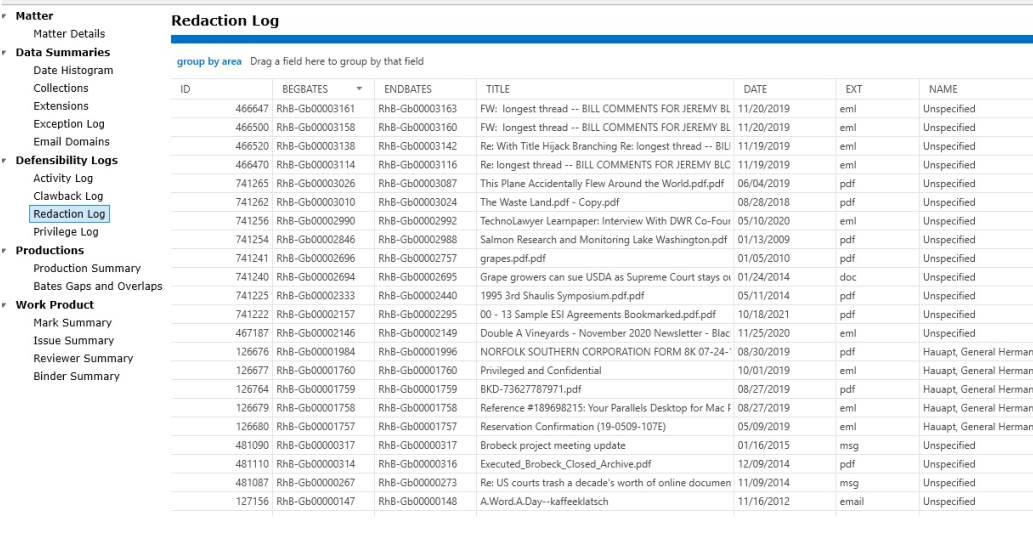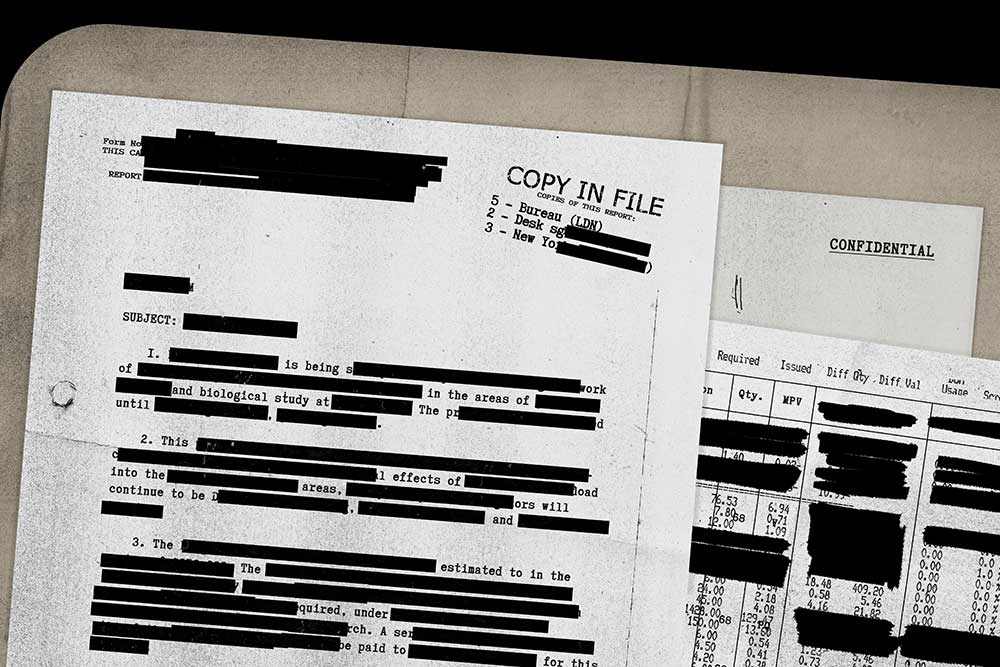Redacting documents is a fact of life in litigation and investigations. But redactions without context breed mistrust, motion practice, and (sometimes) sanctions. The practical antidote is a redaction log—a short, structured record that explains what was redacted and why. This article explains what redaction logs are, how they differ from privilege logs, why they’re critical in both U.S. eDiscovery and UK disclosure, and how to implement them defensibly.
DWR eDiscovery provides built-in redaction and auto redaction tools for both efficiency (speed) and compliance. DWR auto-reaction tools are the most accurate and advanced in the industry.

What is a redaction log?
A redaction log is a record—often exported from your review platform—that lists each redaction made to a produced document and states the basis (e.g., attorney–client privilege; work product; personal data; trade secret; or, where permitted, non-responsive confidential material). In U.S. practice, the Federal Rules of Civil Procedure don’t use the phrase “redaction log,” but they do require a withholding party to describe the nature of withheld material in a way that enables other parties to assess the claim without revealing the protected information; many teams satisfy that obligation as to redactions by providing a targeted log. Legal Information Institute
In the UK’s Business & Property Courts, the requirement is explicit: any redaction must be accompanied by an explanation of the basis and confirmation that a responsible legal representative has reviewed it (PD 57AD ¶16.2). In other words, a redaction log (or equivalent annotation) isn’t optional—it’s built into the disclosure regime. GOV.UK Justice
Redaction vs. privilege logs (and how they interact)
A privilege log lists documents withheld or partly withheld for privilege or work product and is expressly contemplated by U.S. Rule 26(b)(5)(A). Where a document is produced with narrow redactions for privilege (e.g., the legal advice line in an otherwise discoverable email), many practitioners satisfy their Rule 26 duties with either a combined privilege/redaction log entry or clear on-page redaction reasons plus a slim log that ties back to the Bates number and redaction reason codes. The ABA has noted that selective redaction (especially in email threads) can reduce disputes by preserving context and avoiding wholesale withholding—so long as you document the basis. Legal Information Institute+1
Sedona’s 2024 Commentary on Privilege Logs likewise encourages proportional, information-rich logging approaches that meet Rule 1’s mandate of “just, speedy, and inexpensive” determinations, while giving opponents enough detail to assess claims. Redaction logs are a natural complement to those approaches. The Sedona Conference
Why redaction logs are essential
1) Transparency that prevents motion practice
Opposing counsel rarely object to redactions they understand. A concise log—Bates, page/region, category (e.g., A/C privilege), and a brief description—lets recipients decide whether to challenge. Courts repeatedly fault parties who offer redactions with no intelligible basis; the cure is a contemporaneous explanation. In the UK, PD 57AD hard-codes this: explain every redaction and identify a supervising lawyer. GOV.UK Justice
2) Compliance with rules—and with what courts actually allow
U.S. relevance-only redactions: Most federal courts disfavor unilateral “relevance” redactions from otherwise responsive documents absent agreement or order; the Rules tell you to object, seek a protective order, or produce under an appropriate confidentiality regime—not to self-edit for relevance. That’s why, if relevance redactions are allowed, a clear log is critical. E-Discovery LLC+2ediscoverytoday.com+2
UK disclosure: The UK expressly permits redaction for irrelevant and confidential material and for privilege, but requires an explanation for each redaction (again pushing you toward a log). GOV.UK Justice
3) Defensibility and auditability
If a court asks “why was this line blacked out?”, you need more than memory. A redaction log creates a defensible audit trail showing the basis and reviewer. Sedona emphasizes defensible, proportionate logging calibrated to actual disputes and volumes; adding structured redaction logging is aligned with that philosophy. The Sedona Conference
4) Efficiency: fewer disputes, faster meet-and-confers
Good logs support targeted meet-and-confers. Rather than arguing “your redactions are improper,” counsel can point to specific entries where the basis seems thin (e.g., “personal data” in a corporate org chart) and resolve them quickly. This reduces time-consuming in camera review requests and shotgun motion practice. Practical commentary from U.S. litigators and eDiscovery blogs shows courts increasingly deciding narrow redaction disputes—and they often look favorably on parties who documented their choices. ediscoverytoday.com+1
5) Cross-pollination from FOIA practice
Public-records regimes have long required Vaughn indices, which detail each withheld/redacted item and the statutory exemption asserted—essentially a public-law redaction log. The DOJ’s guidance and FOIA case law show how detailed indices help courts determine whether redactions were proper and whether segregable information was released. That same logic applies in civil cases: clearer logs = fewer fights. Department of Justice+2FOIA.Wiki+2
What to include in a redaction log
A defensible log doesn’t need to be verbose; it needs to be consistent and informative. At minimum:
- Bates number (and page) where the redaction appears.
- Redaction area identifier (line, paragraph, or region) to avoid ambiguity.
- Category (e.g., Attorney–Client Privilege; Work Product; PII/Personal Data; Trade Secret).
- Brief description of the nature of the redacted content sufficient to let the other side assess the claim without revealing the substance (mirroring Rule 26(b)(5)(A)’s standard). Legal Information Institute
For UK disclosure, add the required explanation and the confirmation of review by a supervising legal representative to satisfy PD 57AD ¶16.2. Many UK teams satisfy this by including a “Reason” code and “Notes” field in the log export, plus a line in the disclosure certificate that the supervising solicitor has reviewed redactions. GOV.UK Justice
When a redaction log is especially important
- Email threads and chats: Redacting a single privileged sentence instead of withholding an entire thread preserves context; a log entry for that snippet prevents confusion. (The ABA specifically notes the value of targeted redaction in emails.) American Bar Association
- Mixed-content documents: Think incident reports mixing legal advice, business analysis, and PII. A log lets you surgically protect each category.
- Sensitive personal or proprietary data: If your basis is confidentiality (rather than privilege), U.S. courts typically expect a protective order, not unilateral redactions—unless agreed. If relevance/confidentiality redactions are permitted, careful logging is essential to show compliance with the agreement or order. E-Discovery LLC+1
- UK matters under PD 57AD: Every redaction needs an explanation and lawyer confirmation—functionally, a redaction log by rule. GOV.UK Justice
Pitfalls and how logs help you avoid them
- Unilateral relevance redactions (U.S.)
Courts frequently reject them. If you must pursue them, document the basis, tie them to a protective order, and log them clearly—or expect a motion to compel. E-Discovery LLC+1 - Over- or under-disclosure of log detail
Too little detail triggers motion practice (“we can’t assess your claim”); too much risks revealing the very substance you’re protecting. Sedona recommends proportionality: enough to assess, not so much that you waive. Use reason codes plus short, non-revealing descriptions. The Sedona Conference - Inconsistent reasons and reviewer “drift”
Without standardized reason codes and QC, different reviewers will apply different standards. A structured log (ideally exported directly from the review tool) enforces consistency and supports quality control. - Forgetting the meet-and-confer story
Logs aren’t just for the court; they’re for your counterpart. Sharing your categories and examples early often heads off disputes. Thoughtful commentary from courts and practitioners shows that agreements up front about if/when non-privilege redactions are permitted can eliminate later fights. E-Discovery LLC+1
A short, practical template
Whether you’re in the U.S. or UK, you can operationalize redaction logging with a lean schema:
- Bates: ABC-000123
- Page/Region: p.3, ¶2 (lines 3–5)
- Reason Code: A/C Privilege (U.S.); Privilege (UK)
- Description: “Legal advice from in-house counsel regarding litigation strategy.”
- Authority: Rule 26(b)(5)(A) (U.S.); PD 57AD ¶16.2 (UK)
- Reviewer: Initials of reviewer; date
- Supervisor Confirmation (UK): Included in disclosure certificate or log meta
This is enough to let the recipient assess the claim, satisfies U.S. withholding-description requirements, and aligns with UK redaction-explanation obligations. Legal Information Institute+1
Special note on public-records and regulatory productions
If you handle FOIA or FOIA-adjacent work, a Vaughn-style index is mandatory: identify each withheld/redacted portion and tie it to a specific statutory exemption, with enough detail for the court to review (often without in camera inspection). The DOJ’s guidance and FOIA references are a useful north star for how granular a log should be when your audience is a court, not just opposing counsel. Department of Justice+2FOIA.Wiki+2
Sanctions and consequences
While sanctions for redaction missteps are rarer than for spoliation, inadequate logging can lead to compelled re-production, fee shifting, or orders to lift redactions. Contemporary eDiscovery case surveys highlight courts scrutinizing redactions (especially for non-responsive content) and ordering full re-productions where agreement or adequate explanation was lacking. A careful log often avoids that outcome—or minimizes the remedy. Sidley Austin+1
Bottom line
Redaction logs convert black boxes into defensible decisions. In the U.S., they dovetail with Rule 26(b)(5)(A)’s requirement to describe withheld material; in the UK Business & Property Courts, they are effectively mandatory via PD 57AD ¶16.2. Used well, they reduce disputes, speed meet-and-confers, protect genuinely sensitive material, and keep you aligned with proportionality and cooperation principles championed by courts and The Sedona Conference. The costs are modest; the dividends—in trust, efficiency, and defensibility—are significant. Legal Information Institute+2GOV.UK Justice+2
Selected sources
U.S.: FRCP 26(b)(5)(A); ABA Business Law Today on targeted redactions; court and practitioner commentary on relevance redactions. ediscoverytoday.com+3Legal Information Institute+3American Bar Association+3
UK: Practice Direction 57AD ¶16 (redaction and explanation); CPR Part 31 overview; practitioner guidance on disclosure. GOV.UK Justice+2GOV.UK Justice+2
FOIA: DOJ/OIP Vaughn-index guidance; FOIA Wiki; CRS overview of FOIA exemptions. Department of Justice+2FOIA.Wiki+2
-1.png?width=400&height=164&name=DWRLogoClassic%20-%20Copy%20(2)-1.png)









Comment On This Article